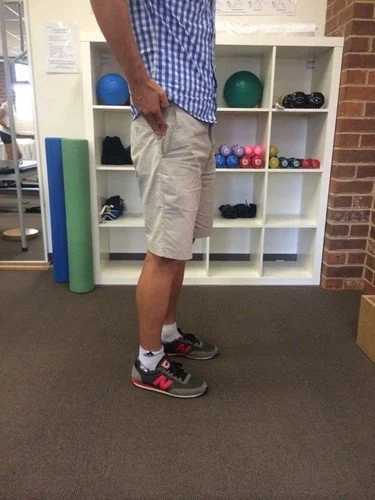Our Guide to Managing Gluteal Tendinopathy
Aidan Rich, APA Sports and Exercise Physiotherapist
Gluteal tendinopathy is a common musculoskeletal condition and is also known as greater trochanteric pain syndrome (GTPS), and sometimes referred to as ‘gluteal tendinitis’ or ‘bursitis’. It causes localised pain on the outside of the hip and can cause pain and disability with activities like walking (particularly upstairs or up hills) and sleeping. It occurs more commonly in females, particularly over the age of 50. Even though a tendon issue can sound minor, research (Fearon 2014) has shown that gluteal tendinopathy can cause disability and quality of life changes similar to those seen with severe hip osteoarthritis
Figure 1: Location of bony bump on femur
What causes gluteal tendinopathy?
This is complicated and there is no single answer, however it is thought that a rapid increase in exercise (walking, hiking, running) that exceeds the ability of the tendon to adapt is a common cause. In addition, there are potentially other systemic issues (hormonal changes related to menopause, cholesterol/insulin resistance changes, loss of global strength) that may contribute.
What are the key features that we look for to make the diagnosis of gluteal tendinopathy?
Most people with this condition have similar features, although there is some individual variability:
Pain localised to the bony ‘bump’ on the outside of the hip (femur) (see Figure 1). Occasionally there is radiation down the outside of the thigh
Pain on palpation of the tendons in this region (Fearon 2012, Ganderton 2014)
Reproduction of pain with the FABER (Flexion, Abduction, External Rotation) test (Fearon 2012, Ganderton 2017) (see Figure 2)
Pain with laying on the affected side for prolonged periods (particularly on hard surfaces)
Reproduction of pain when contracting the gluteal muscles, particularly when they are being stretched (this is a difficult one to do at home!)
Symptoms that are worse with more activity, particularly if this involves hilly or longer walking or running.
Figure 2: FABER Test
How do I treat gluteal tendinopathy?
This can be a challenging condition to treat particularly in severe cases however there is research investigating the following treatments:
Education – advice on topics such as monitoring pain, high and low tendon loads, gradual changes in activity has been shown to be effective when combined with exercise (Mellor 2018)
Exercise – an exercise program for the gluteal muscles (and other muscles of the lower limb) has been shown to be effective (Mellor 2018). Specific exercise may be more helpful in more active people (Ganderton 2018).
Corticosteroid injection. This one is a bit controversial! Research (Mellor 2018) suggests that a single injection is more helpful than nothing, but not as helpful as education and exercise. There are thought to be risks with multiple injections. No study has compared corticosteroid injections to a placebo.
Hormone therapy. Another controversial one – some Melbourne research suggests that estrogen therapy may be beneficial in post-menopausal females, particularly those with a body mass index (BMI) of less than 25.
Platelet rich plasma (PRP) injections. There is limited research showing benefit of PRP injections when compared to an appropriate comparison group.
Your physiotherapist can help you to diagnose the treat this condition with an individualised treatment approach. Author of this article, Aidan Rich, is completing his PhD on the ‘sister’ of this condition – proximal hamstring tendinopathy and regularly treats people with gluteal tendinopathy.
References
Fearon, A. M., Scarvell, J. M., Neeman, T., Cook, J. L., Cormick, W., & Smith, P. N. (2013). Greater trochanteric pain syndrome: defining the clinical syndrome. British journal of sports medicine, 47(10), 649-653.
Fearon, A. M., Cook, J. L., Scarvell, J. M., Neeman, T., Cormick, W., & Smith, P. N. (2014). Greater trochanteric pain syndrome negatively affects work, physical activity and quality of life: a case control study. The Journal of arthroplasty, 29(2), 383-386.
Ganderton, C., Semciw, A., Cook, J., & Pizzari, T. (2017). Demystifying the clinical diagnosis of greater trochanteric pain syndrome in women. Journal of Women's Health, 26(6), 633-643.
Mellor, R., Bennell, K., Grimaldi, A., Nicolson, P., Kasza, J., Hodges, P., ... & Vicenzino, B. (2018). Education plus exercise versus corticosteroid injection use versus a wait and see approach on global outcome and pain from gluteal tendinopathy: prospective, single blinded, randomised clinical trial. bmj, 361.
Aidan Rich is an APA Sports Physiotherapist at Advance Healthcare in Boronia. Aidan's post-graduate qualifications in Sports Medicine enable him to educate the patient regarding the nature of their diagnosis, as well as empower them with the best methods to return to their normal level of function as soon as possible.




